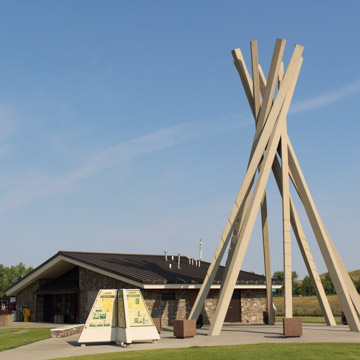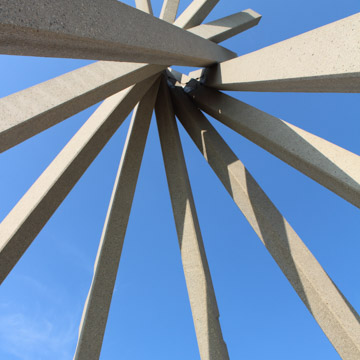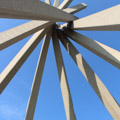With the development of the interstate highway system in the 1950s came guidelines for Safety Rest Areas (SRAs), which included running water, flush toilets, picnic tables, shelters, and walking paths. Further standardization occurred with the passing of the Highway Beautification Act of 1965. Although the amenities were standardized, each state could adopt designs that would represent its unique historical or cultural identity. As a result, SRAs became expressions of regional flavor and modern architectural design. Along South Dakota’s two interstate highways, I-90 (east-west) and I-29 (north-south), are nine concrete tipis built by Sioux Falls architect Ward Whitwam between 1968 and 1979. The tipis evoke the American Indian history and culture in South Dakota. The first two were built at rest areas on either side of I-90 near Wasta.
The tipis are constructed of eight prestressed concrete poles that represent the lodgepole framing structure of an American Indian tipi. The poles, each of which rises 56 feet and weighs 6.5 tons, are set into 35-foot-diameter concrete base. Each pole is notched and inlaid with a steel plate where it intersects with the others at the top in a spiral composition that results in a 3-foot-diameter opening at the top.
Whitwam also paid tribute to pioneer settlers with his original design for a dug-out, sod-covered restroom facility. The sloped ends of the building curved around one half of the tipi, forming a circular plaza in front; railings above the building provided protection for those atop the structure, which resembled a low hillside from afar. These dug-outs were unfortunately demolished to build facilities with larger restrooms. The new buildings are single-story, rectangular structures of native fieldstone and contain visitors’ centers and restrooms, all gathered under a shallow gable roof.
Like other oversized roadside attractions, such as Dinosaur Park in Rapid City or the Milbank windmill, these concrete tipis are well-known landmarks to those regularly traveling the highways. There are five other tipis on I-90, two at Salem, and one each at Valley Springs, Chamberlain, and Spearfish; two others are on I-29 at New Effington and Junction City.




